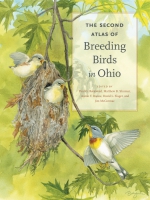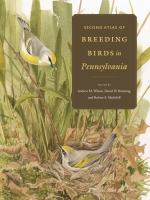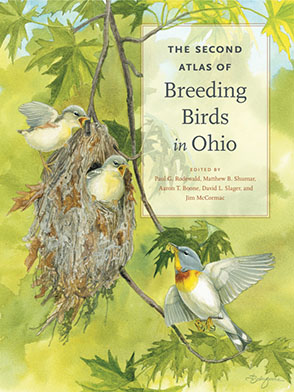
The Second Atlas of Breeding Birds in Ohio
Edited by Paul G. Rodewald, Matthew B. Shumar, Aaron T. Boone, David L. Slager, and Jim McCormac
The Second Atlas of Breeding Birds in Ohio
Edited by Paul G. Rodewald, Matthew B. Shumar, Aaron T. Boone, David L. Slager, and Jim McCormac
“The enormous effort to document the avifaunal biodiversity and patterns of species distributions within Ohio in this second Atlas is matched by a thorough treatment and presentation of the data that should be of interest to a broad audience.”
- Media
- Description
- Reviews
- Bio
- Table of Contents
- Sample Chapters
- Subjects
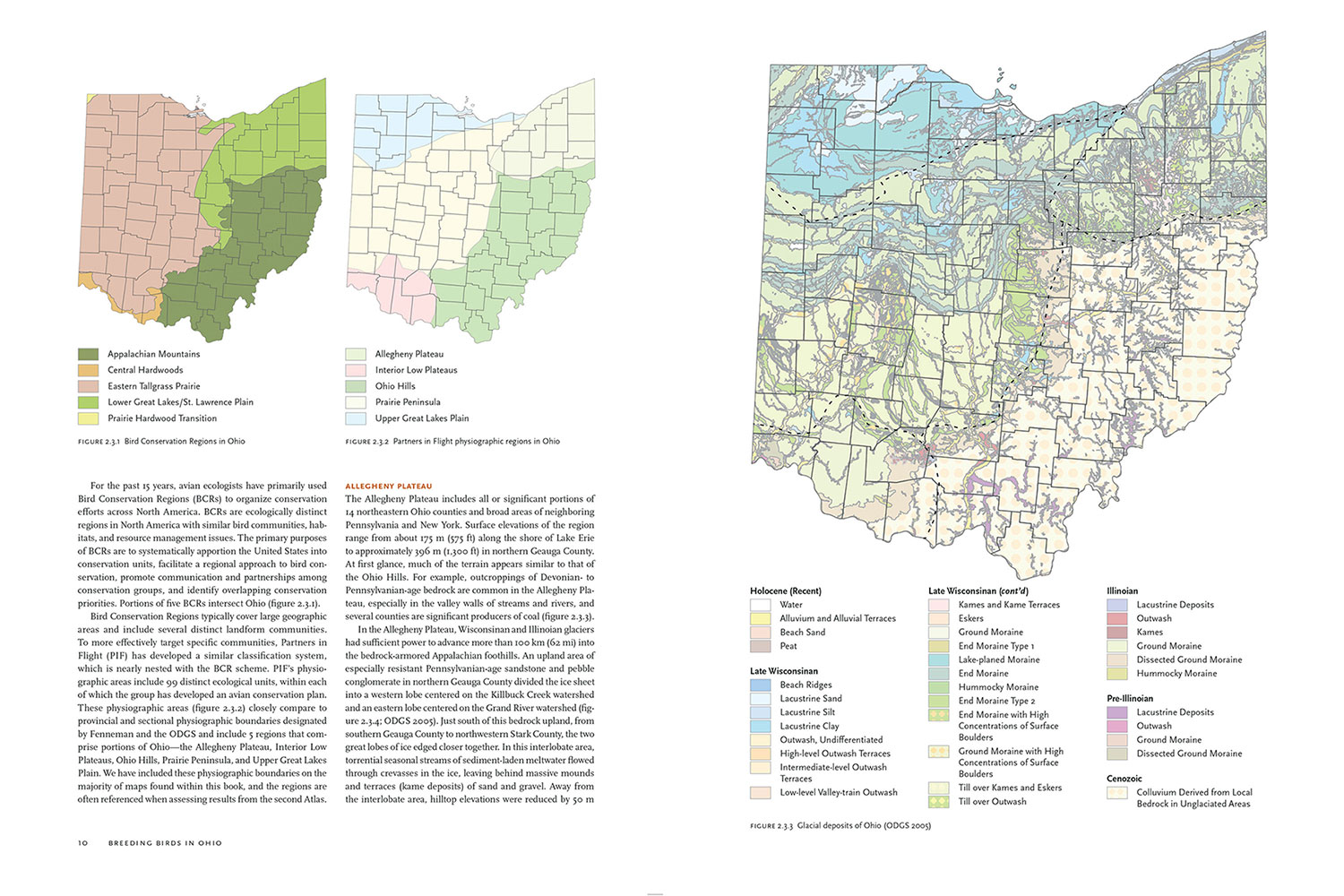
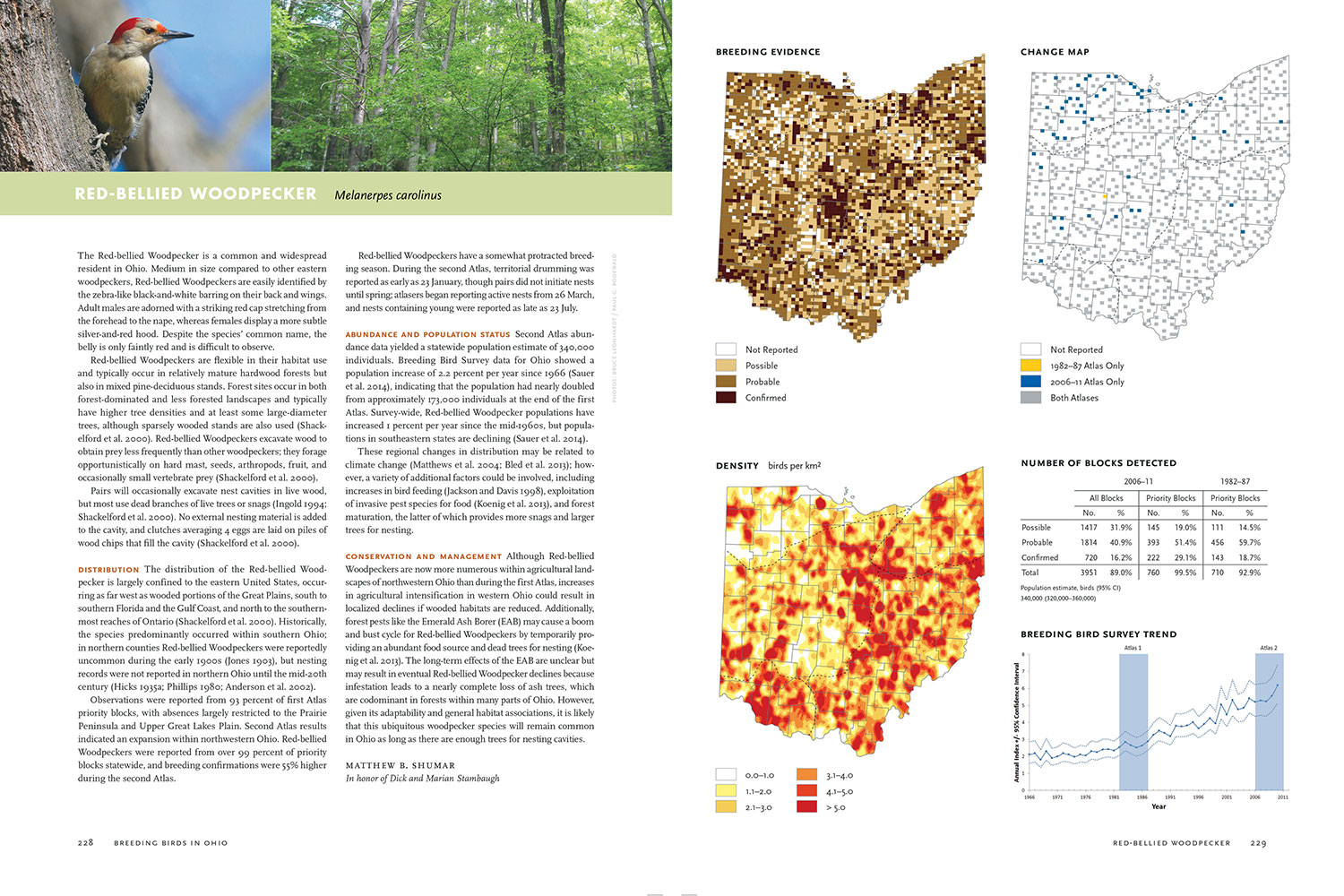
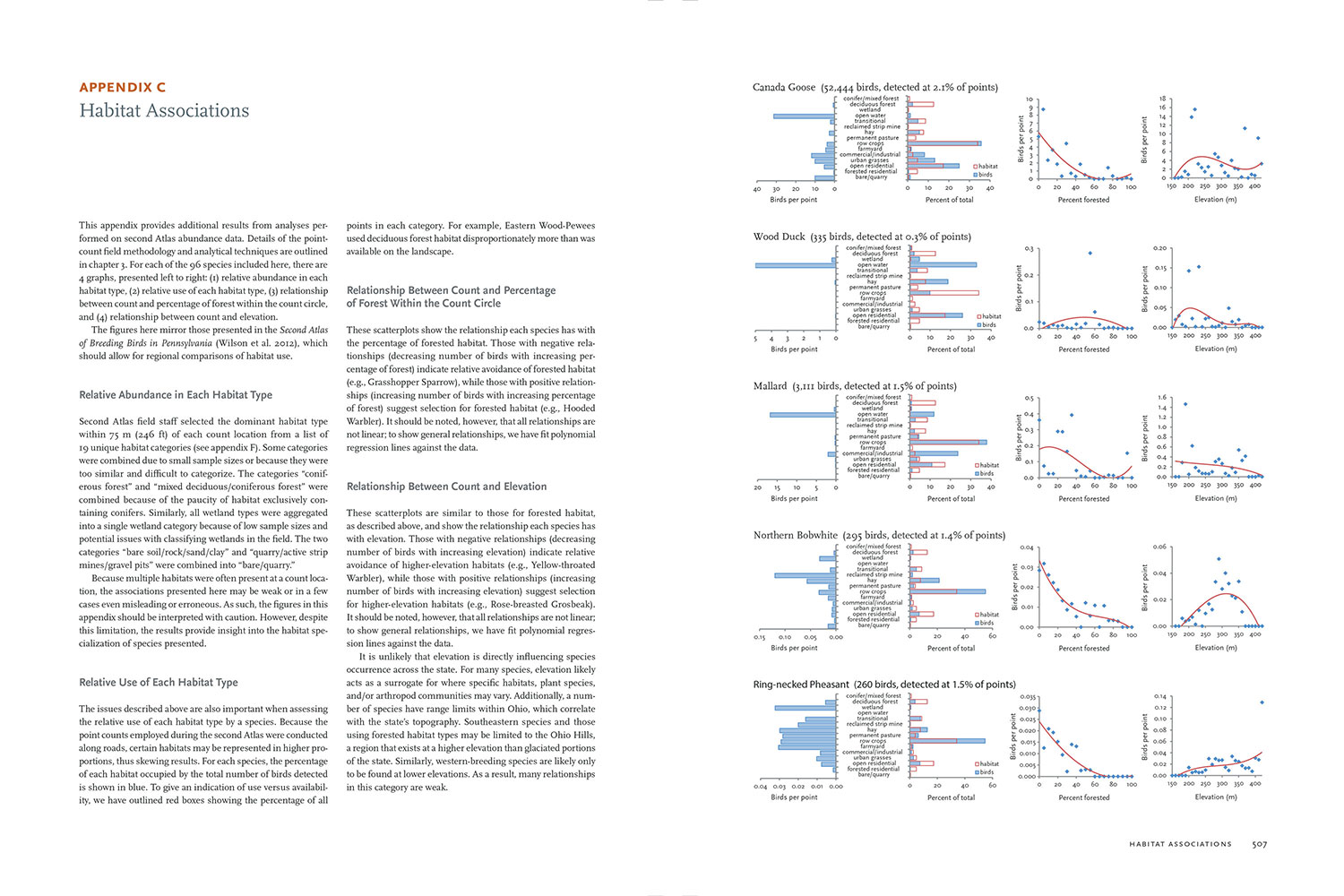
More than nine hundred dedicated birdwatchers completed surveys of birds across the state from 2006 to 2011. In addition, trained staff collected new data on bird abundance using point-count surveys. These counts tabulated not only species but individual birds as well, enabling precise estimates of the actual statewide populations for many of the breeding species detected. In all, more than one million bird records were compiled by birders and professional researchers for the second Atlas, providing an unprecedented snapshot of the bird life of Ohio.
The introductory chapters describe and discuss recent changes in climate and bird habitats within Ohio. The bulk of the volume contains comprehensive and authoritative accounts of each species, illustrated by stunning full-color photographs. Species maps show in fine detail the birds’ distribution, habitat, and range, and, for nearly one hundred species, their abundance in Ohio. This Atlas will aid and inform researchers and birders for years to come.
“The enormous effort to document the avifaunal biodiversity and patterns of species distributions within Ohio in this second Atlas is matched by a thorough treatment and presentation of the data that should be of interest to a broad audience.”
Paul G. Rodewald is editor of Birds of North America Online, based at the Cornell Lab of Ornithology.
Matthew B. Shumar is a wildlife biologist specializing in ornithology and landscape ecology.
Aaron T. Boone has been a lifelong birder and has worked as a field ornithologist on research projects across the United States.
David L. Slager has a long-standing interest in the natural history of birds and conducts field research on avian ecology, evolution, and behavior across the Americas.
Jim McCormac works for the Ohio Division of Wildlife and has written two books and many articles about Ohio’s birds.
Contents
Acknowledgments
Chapter 1: Introduction
Chapter 2: Habit and Environmental Features
Chapter 3: Survey Design and Analytical Methods
Chapter 4: Summary of Avifaunal Changes between Atlases
Chapter 5: Guide to Interpreting Species Accounts
Chapter 6: Species Accounts
Chapter 7: Implications for Bird Conservation in Ohio
Appendix A: Rare or Potential Non-breeding Species
Appendix B: Summary of Atlas Results by Physiographic Region
Appendix C: Habitat Associations
Appendix D: Breeding Phenology
Appendix E: Common and Scientific Names for Referenced Flora and Fauna
Appendix F: Field Cards
Appendix G: Safe Dates
Literature Cited
Index
Chapter 1 | Introduction
Paul G. Rodewald
Development of Atlasing
Bird atlases are citizen science projects that map the distributions of bird species using a grid system to document their presence or absence. The concept was developed during the late 1950s with the Atlas of the British Flora (Perring and Walters 1962), but soon expanded to birds and other taxa. Fieldwork for the very first bird atlases started in Great Britain during the late 1960s (Lord and Munns 1970). These early efforts were important because they led to a multitude of atlas projects in both Europe and abroad during subsequent decades. This included the first breeding bird atlases in North America during the 1970s and early 1980s, including Maryland, Massachusetts, Vermont, and Ontario among others. Indeed, over 400 bird atlases have now been completed worldwide (Gibbons et al. 2007). Most bird atlases have focused on breeding distributions, and these projects have targeted a range of spatial scales from continental efforts like in Australia (Barrett et al. 2003), to more local scales as seen in San Diego County, California (Unitt et al. 2004).
Breeding bird atlases typically collect data over multiple years and are excellent examples of how citizen science can benefit ornithology and bird conservation. Although very few of the first generation atlases in North America collected data on bird abundance, these projects did collect essential baseline data on bird occurrence and contributed immensely to our understanding of how birds are distributed. This is readily seen in the species range maps displayed in many field guides and in the Birds of North America species accounts (Poole 2014).
By design, bird atlases were intended to be periodically repeated and the typical approach has been to conduct second atlas projects 20-25 years after the start of the initial project. Second atlases greatly expand the value of atlasing efforts by generating datasets that allow researchers to test for changes in the distributions of all species that occur within a region (assuming adequate sample sizes). This information is very timely given concern about how changes in climate and land use (e.g., agricultural intensification) are affecting bird populations. Data from second atlas projects in North America are already contributing to important research. For example, results from the second breeding bird atlas in New York (McGowan and Corwin 2008) were used to show that northward shifts in range boundaries of some species were associated with warming temperatures (Zuckerberg et al. 2009).
<1>1.2 Ohio Breeding Bird Atlas: 1982-1987
Ohio was among the first states in the U.S. to initiate a statewide atlas of breeding birds. The first Ohio Breeding Bird Atlas (hereafter first Atlas) was organized and coordinated by the Division of Natural Areas and Preserves in the Ohio Department of Natural Resources. Fieldwork was conducted during a six-year period from 1982-1987, with atlas results being published four years later (Peterjohn and Rice 1991). Like most first projects, the primary goal of the first Atlas was to document the status and distribution of all birds breeding within the state (Peterjohn and Rice 1991). There were multiple additional objectives in the first Atlas and all of these substantially overlap with the objectives of the second Atlas in Ohio, which are described below.
The first Atlas was an unprecedented effort that generated new and important data on Ohio’s breeding birds during the 1980s. More than 500 volunteers contributed over 30,000 hours of their personal time during the collection of field data which resulted in more than 102,700 breeding bird records. A total of 182 species were confirmed as breeding within Ohio, and records were obtained for new breeding species like the Snowy Egret, Little Blue Heron, and Mute Swan. Statewide surveys were focused on 764 priority blocks that were found to include from 48 to 115 species with an overall average of 78 species per block (Peterjohn and Rice 1991).
<1>1.3 Ohio Breeding Bird Atlas II: 2006-2011
The Ohio Breeding Bird Atlas II (hereafter second Atlas) was coordinated by the School of Environment and Natural Resources at The Ohio State University. Fieldwork was conducted during a six-year period from 2006 to 2011; see Chapter 3 for details on project planning, organization, and methodology. The goals of the second Atlas were to:
● Determine the status and distribution of Ohio’s breeding birds and provide new data on the nesting of Ohio’s Endangered, Threatened, Special Concern, and Special Interest species
● Compare data collected during the first and second atlas projects to evaluate changes in bird distributions within Ohio over the last 25 years
● Estimate the statewide abundance of breeding bird species
● Determine the distribution of wetland and nocturnal species using special surveys
● Identify habitats/sites that are associated with a high diversity of breeding birds or the presence of endangered and threatened species
● Partner with birding and bird conservation groups statewide and engage hundreds of birders, outdoor enthusiasts, and other Ohioans in second Atlas efforts
By design, these goals closely matched those of the first Atlas in order to maximize comparability between atlas periods. As a result, the second Atlas had the unique opportunity to examine changes in species distributions within Ohio over a 25-year period. However, survey coverage was expanded statewide to survey birds within 4,437 atlas blocks—a six-fold increase. Beyond collecting distribution data, significant time and resources were invested in trained staff that collected new data on bird abundance using point-count surveys. This allowed the second Atlas to generate population estimates for individual species and to map their densities across the state. Further, the distribution of secretive marshbirds (e.g., rails, bitterns) was assessed for glaciated regions of Ohio using call-broadcast surveys.
Over 900 individuals contributed to the second Atlas project. Volunteers that contributed data through the second Atlas website reported over 70,000 hours of personal time and nearly 400,000 miles driven, demonstrating their strong commitment to the project while contributing significantly to Ohio’s economy. More than one million bird records were generated by the project, with records from all 4,437 blocks. Overall, there were 204 species with some evidence of breeding, including 194 confirmed breeding species and ten species with either possible or probable breeding status. There were five new breeding species for Ohio and five species that were not reported breeding for 50-100 years. Surveys of the 764 priority blocks were found to include from 44 to 119 species with an overall average of 76 species per block.
The extensive survey efforts of volunteers and paid staff generated an unprecedented dataset on the breeding birds of Ohio, one that has rarely been duplicated in other states. This new information will be invaluable given concerns about the impacts of climate and land cover change on birds, and should be central to the development of effective conservation planning and management of bird populations in Ohio. The ultimate value of the time and resources devoted to developing the second Atlas dataset will be especially apparent once the state initiates work on the third Ohio breeding bird atlas in approximately 2030.
<1>1.4 About This Book
<2>References
The Second Atlas of Breeding Birds in Ohio draws upon a diverse body of ornithological literature to discuss the historic status, distribution, and natural history of birds that breed within Ohio and the broader region. This includes peer-reviewed journal articles, especially those covering North American ornithology (The Auk: Ornithological Advances, The Condor: Ornithological Applications, Journal of Field Ornithology, Wilson Journal of Ornithology) and a series of National Audubon Society publications that summarized bird occurrence and distribution over many decades (Bird-Lore, Audubon Field Notes, American Birds, Field Notes, and North American Birds). State bird journals were often referenced for both bird records and articles, including the Ohio Cardinal, Cleveland Bird Calendar, and The Bobolink.
Of special importance in writing this volume were several books detailing the status and distribution of birds in Ohio, and those works cited most often are listed in Table 1.4.1. Although the history of ornithologists working within Ohio stretches back over 200 years and includes visits to the state by John James Audubon and Alexander Wilson during the early 1800s (Peterjohn 2001), it was not until the 1830s when Jared Kirtland published the first summary of all the birds of Ohio (Kirtland 1838). There were other important early reports on the state’s birds, including those by John Maynard Wheaton (1882), William L. Dawson (1903), and Lynds Jones (1903). However, it was not until the 1930s that Lawrence E. Hicks published the first report emphasizing the statewide distributions of breeding birds. Hicks (1935a) produced an assessment of the species reported to nest with each of Ohio’s 88 counties. After the mid-1930s, most of the important works on birds in Ohio have been either regional in focus [e.g., Trautman (1940), Campbell (1940, 1968), Williams (1950), Anderson et al. (2002), Trautman and Trautman (2006)] or annotated checklists of bird species documented within the state [e.g., Borror (1950), Trautman and Trautman (1968), Peterjohn et al. (1987)].
Following the work of Hicks during the mid-1930s, the next statewide assessment of the state’s breeding avifauna was the first Atlas book (Peterjohn and Rice 1991); this work provided the first comprehensive assessment of the distribution of breeding birds in Ohio. Peterjohn and Rice (1991) was so heavily used within the second Atlas book, that in referencing results from the first Atlas authors do not cite Peterjohn and Rice (1991), which is rather typical practice for second Atlas books given space limitations within species accounts. However, Peterjohn and Rice (1991) was cited in situations where a second Atlas account has drawn upon the authors’ interpretation of results from the first Atlas. Finally, the most recent book by Bruce Peterjohn (Peterjohn 2001) presents an excellent and exhaustive coverage on the status and distribution of Ohio’s birds; understandably, this work was heavily cited throughout the second Atlas book.
<insert Table_1.4.1 here>
<2>Acronyms and abbreviations
Given space limitations in this book, especially for species accounts, numerous abbreviations and acronyms were used (Table 1.4.2). Measurements are presented using the metric system with English units provided in parentheses.
<insert Table_1.4.2 here>
<2>Commonly referenced site names
A large number of sites are mentioned in the book to describe bird distributions. County names are provided for infrequently mentioned locations, but to save space commonly mentioned locations often do not provide the county name; Table 1.4.3 provides location information for these sites, which are shown in Figure 1.4.1.
<2>Availability of second Atlas data
The second Atlas was supported through public funding, and data collected by the project will be made available by request to the Ohio Division of Wildlife.
Also of Interest
Mailing List
Subscribe to our mailing list and be notified about new titles, journals and catalogs.
